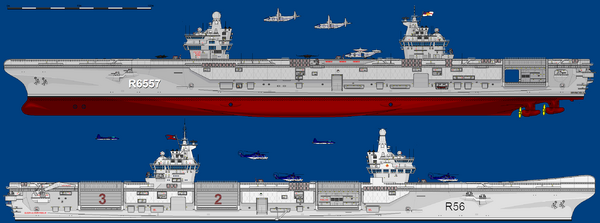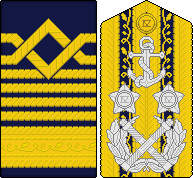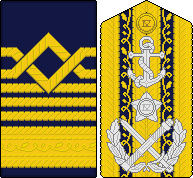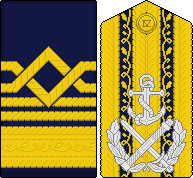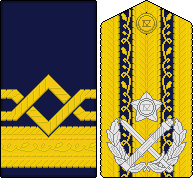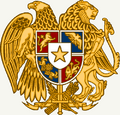Kouralian Royal Navy: Difference between revisions
No edit summary |
(→Ranks) |
||
| (35 intermediate revisions by the same user not shown) | |||
| Line 1: | Line 1: | ||
{{infobox national military | {{infobox national military | ||
|country = | |country = Crown Union of Kouralia | ||
|name = | |name = Tempestas de ferro in sal<br>''Storm of steel in salt'' | ||
|image = [[Image:Kouralian Naval Ensign.png|300px]] | |image = [[Image:Kouralian Naval Ensign.png|300px]] | ||
|caption = The Flag of the Kouralian Royal Navy | |caption = The Flag of the Kouralian Royal Navy | ||
|founded = | |founded = 350 BCE | ||
|current_form = | |current_form = 2001 | ||
|Motto = Tempestas de ferro in sal | |Motto = Tempestas de ferro in sal | ||
|headquarters = | |headquarters = Palæe Naughilus | ||
<!-- Leadership --> | <!-- Leadership --> | ||
|commander-in-chief = | |commander-in-chief = Alyxandra Campbell | ||
|commander-in-chief_title= | |commander-in-chief_title=Queen | ||
|minister = | |minister = Tamæra Carfagna | ||
|minister_title = | |minister_title = Legatine Justiciar | ||
|commander = | |commander = Sir Alessya Cæryn | ||
|commander_title = | |commander_title = Lord and Master of the Admiralty | ||
<!-- Manpower --> | <!-- Manpower --> | ||
|age = 18-63 | |age = 18-63 | ||
| Line 21: | Line 21: | ||
|active = 2,500,000 | |active = 2,500,000 | ||
|reserve = 300,000 | |reserve = 300,000 | ||
}} | }} | ||
The '''Kouralian Royal Navy''' is the | The '''Kouralian Royal Navy''' is the marine warfighting service of the [[Kouralia|Kouralian]] [[Kouralian Military|Military]] and is a fully fledged Blue-Water Navy which operates throughout [[Mystria]] and beyond. While it is not the 'favoured child' of the three service branches, the Navy still operates a modern, disciplined, and well-equipped force. | ||
It is responsible for crewing all ships, landing craft and patrol boats in the military - though there are some smallcraft operated by the Corps of Engineers of the Royal Army, or by the Air Force's Coastal Warfare Command. The Navy also has responsibility for all aircraft embarked on Naval ships and for the Fleet Fusilier Guard - a force of infantrymen who secure naval vessels and facilities, along with assisting army expeditionary troops in landings. | It is responsible for crewing all ships, landing craft and patrol boats in the military - though there are some smallcraft operated by the Corps of Engineers of the Royal Army, or by the Air Force's Coastal Warfare Command. The Navy also has responsibility for all aircraft embarked on Naval ships and for the Fleet Fusilier Guard - a force of infantrymen who secure naval vessels and facilities, along with assisting army expeditionary troops in landings. | ||
==History== | |||
[[Image:Wiki Ancient Kour Navy.jpg|right|250px|thumb|Artist's impression of an ancient Kouralian {{wp|Trireme}}]] | |||
The Navy can trace its lineage back to the Læfaaſtyc Legionæ which were originally a part of the Crown Host - the professional predecessor to the [[Royal Kouralian Army]]. These were a blend of civilian mariners who ran the ships and oarsmen who were little more than uneducated labourers to propel them, and the trained soldiers and officers who did the fighting and commanded the ships. An average ship might have a Sailing Master who was a civilian ship's captain who was responsible for seamanship and for managing the sailors and oarsmen. It would also have a Centenær who, on land, would be in charge of roughly a hundred Legionaries, but at sea may be in charge of twenty to thirty soldiers on top of the sailing crew. This Centenær was responsible for directing the Sailing Master where to go, and when battle was joined he would take responsibility for overall command. | |||
The professionalism of the Navy took a long time to catch up with the Army, and it wasn't until roughly the twelfth century that the modern 'Warfare' Trade began to take over responsibility for Seamanship, but still it took many more centuries before enlisted sailors became professionals rather than coerced labourers. | |||
==Doctrine== | |||
The Navy has always traditionally been defined by a subordinate role to the [[Royal Kouralian Army|Army]] in its development and its employment. It joins the [[Kouralian National Air Force|Air Force]] in operating dated war machines whose replacements lag behind the turnover of materiel by the Army, and while it rarely struggles to meet recruitment quotas it also joins the juniormost service in having to turn away a far smaller proportion of hopefuls. When it comes to warfighting the maritime sphere is rarely considered in isolation as a form of {{wp|Limited war|limited warfare}} - for example the establishment of a {{wp|Blockade|blockade}} or interdiction of shipping. This is because it is hard for the Kouralian to conceive a war that lacks any form of ground combat. | |||
On a grand-strategic scale the Navy is seen either as the speedbump that screens out some of the chaff before the Army defends the homeland, or it is the cannon which launches the Army into combat against the opposing nation. This is much to the chagrin of the Office of the Admiralty and Marine Affairs, where senior naval officers often have to work far harder than Army or Air Force commanders to advance their service's policies or to advocate for their deployment. | |||
==Organisation== | ==Organisation== | ||
===High Command=== | ===High Command=== | ||
The '''Admiralty Board''' is the | The '''Admiralty Board''' is the professional high command of the Navy. It is made up of the senior-most staff officers, and is regularly joined by senior elected and appointed civilians such as the Justiciar of State for War, or senior [[Crown Adjutant Clerk Corps|civil servants]]. The Chair of the Admiralty is assisted by the Principal Fleet Warrant Officer, who is the service's senior enlisted advisor. It is their responsibility to keep a link open between the high command and enlisted personnel. | ||
* '''Lord and Master of the Admiralty''' - professional head of the Royal Navy. | * '''Lord and Master of the Admiralty''' - professional head of the Royal Navy. | ||
* ''' | * '''Vice-Master of the Admiralty''', and '''Master of the Shore''' - Deputy to the Chair, and responsible for Fleet Reserves and Shore Establishments. | ||
* '''Master of the Fleet''' - responsible for all operational management of vessels. | * '''Master of the Fleet''' - responsible for all operational management of vessels. | ||
* '''Controller of the Fleet''' - responsible for technical support, outfitting, and procuring of vessels. | * '''Controller of the Fleet''' - responsible for technical support, outfitting, and procuring of vessels. | ||
| Line 41: | Line 50: | ||
The Admiralty Board does not exercise operational command of naval forces, as this is passed down via the Joint Service Commands. However, it is responsible for ensuring that sufficient vessels are allocated to each Joint Naval Command to meet its purpose, as well as ensuring they are sufficiently staffed and equipped. | The Admiralty Board does not exercise operational command of naval forces, as this is passed down via the Joint Service Commands. However, it is responsible for ensuring that sufficient vessels are allocated to each Joint Naval Command to meet its purpose, as well as ensuring they are sufficiently staffed and equipped. | ||
===Administrative | ===Administrative Services=== | ||
[[Image:KourWiki Hero Class Carrier.png|right|600px|thumb|FRNS ''Invincible'' and RKNV ''Queen Alyx En Fidelis'', the latter of the Surface Fleet Service.]] | |||
[[Image:KourWiki Hero Class Carrier.png|right|600px|thumb|FRNS ''Invincible'' and RKNV ''Queen Alyx En Fidelis'']] | The Kouralian Navy is divided into multiple branches which are responsible for the administration of particular areas of responsibility. These are all overseen by the '''Office of the Admiralty and Marine Affairs''', the sub-division of the civilian Justiciary of War that is responsible for overseeing the Navy. The Office is also manned by Staff officers from the Naval Staff. | ||
The '''Surface Fleet''' is responsible for | * The '''Surface Fleet''' is responsible for management of all surface combat vessels such as Frigates, AIrcraft Carriers, and even smallcraft like Minehunters and Patrolboats. | ||
* The '''Underfleet''' is responsible for management of all submarines. | |||
* The '''Airfleet''' is responsible for management of all embarked aircraft - whether that be squadrons of strike bombers on a carrier or the single embarked helicopter on a corvette. | |||
* The '''Expeditionary Fleet''' is responsible for management of all Amphibious Warfare ships, and also for the management of the '''Fleet Fusilier Guard'''. These are naval personnel who are primarily responsible for force protection and public facing duties, and limited infantry roles during expeditionary operations. | |||
* The '''Auxiliary Fleet''' is responsible for management of all the Fleet Auxiliary vessels like replenishment oilers, hospital ships, and even mobile workshops capable of performing serious maintenance on ships overseas. | |||
=== | ===Personnel & Trade Branches=== | ||
All personnel are divided into one of the nine Trade Branches, within which they will have a particular specialism that encompasses their day job. The Trade of an enlisted rate is denoted in by a Rate insignia on their right sleeve which complements their rank insignia on the left. Officers wear coloured distinction cloth between the rings on their sleeves, or the devices on their shoulder boards are backed with cloth of that colour. | |||
[[Image:Kour Saluting Guns.png|right|600px|thumb|A justice class frigate navigates past the Crown saluting battery of Kurton]] | |||
* The '''Warfare''' Trade are responsible for the operation of most of the systems on any warship, with personnel divided up into the General Service, Airfleet, and Underfleet branches. Specialisms include Warfare Specialist, Hydrographic & Meteorological Specialist, Fleet Regulator, Naval Airman, and Communication Information Systems Specialist Submarine. Naval vessel commanders are drawn solely from this Trade. Officers of this trade technically wear dark blue distinction cloth, but practically speaking this is represented by having no distinction cloth. Uniquely, Regulating officers wear Regulation Blue distinction cloth. | |||
* The '''Engineering''' Trade are responsible for maintaining and repairing physical equipment, and personnel are divided up into the Weapons, Marine, and Aviation Engineering branches. Specialisms include Technician, Artificer and Mechanic for each branch. Officers of this Trade wear orange distinction cloth. | |||
* The '''Medical''' Trade are responsible for the provision of general and combat medical care to servicepersons - whether that be on a hospital ship, in a naval hospital, or in the clinic on a regular warship. Specialisms include nurses, medical technicians and medical assistants. Officers of this Trade wear red distinction cloth. | |||
* The '''Logistics''' Trade are responsible for providing food, fuel, hospitality and general administration to the Fleet. Specialisms are Chef, Steward, Writer, and Supply Chain. Officers of this Trade wear pale blue distinction cloth. | |||
* The '''Sacoracy''' Trade consists purely of Commissioned Ðyacoſæ and Enlisted Ðyacos' Assistants who are responsible for providing counselling, confidantes, and theological services to the fleet. Officers of this Trade wear white distinction cloth. | |||
== | ==Operational Formations== | ||
The | The Naval Forces assigned to each Joint Service Command are usually made up of permanent formations into and out of which ships are assigned depending on personnel, maintenance, and supplying needs. These ships and smaller formations can be brought into and out of the responsibility of Joint Service Commands by the Admiralty Board, however the Admiralty Board is tasked with ensuring that all JSC Naval Headquarters are adequately staffed to accomplish any strategic aims they are assigned. For the Admiralty Board to remove forces from a JSC without consulting its commander would be an extreme act. | ||
Formations of ships are generally described as follows: | |||
* A '''Numbered Fleet''' is the term for a plurality of Fleets and attached Squadrons. This is usually a permanently established formation into and out of which lesser formations are brought as and when required and which is usually tied to a Joint Service Command. An example of this is the 1st, or '''Grand Fleet''' which is a part of Home Command. | |||
* A '''[[Kouralian Battlefleets|Battlefleet]]''' is the term for the main component of a naval fighting force. That is a Carrier Battlesquadron, a Cruiser Battlesquadron, and two Escort Battlesquadrons. | |||
* A '''Battlesquadron''' is the term for any grouping of vessels which is led by a Carrier or a larger class of Amphibious Warfare vessels. | |||
* A '''Squadron''' is any grouping of vessels not led by one of the above types of vessels. | |||
As an example, the 2nd, or '''Eastern Fleet''' is attached to Mystrian Naval Command. This is made up of a number of patrol, escort, and shore-based support squadrons along with both Battlefleet ''Alexander Kazansky'' and Battlefleet''Helena Wells'' and an Expeditionary Battlesquadron. The Battlefleet ''Alexander Kazansky'' is based at JFB Progress Hill in the [[Malgrave|United Kingdom of Malgrave]] and is made up of the Carrier Battlesquadron ''Alexander Kazansky'', a Cruiser Squadron and two Escort Squadrons. Meanwhile the Battlefleet ''Helena Wells'' is based in the Kouralian colony and is made up of the Carrier Battlesquaron ''Helena Wells'', a Cruiser Squadron and two Escort Squadrons. Supporting this are Mine-Countermeasure Squadrons, independent Escort Squadrons of Corvettes, Frigates and Destroyers, Patrolboat Squadrons at each base, Shore-based Aviation Squadrons, and Auxiliary supply Squadrons. | |||
== | ==Personnel== | ||
===Uniforms=== | |||
Like most Kouralian uniformed services, the Navy has specific 'Numbers' of Dress uniform which correspond to different levels of ceremony and formality. Traditionally each Number of Dress uniform is of a very similar style to the other service's uniforms of that Number. Within the service, the uniform varies slightly depending on the rank or role of the wearer. | |||
* '''Full Dress''' or the ''Steel-dress'' consists of an embroidered navy blue undertunic worn with an enamelled muscle-breastplate with enamelled pteruges embossed with maritime imagery. This uniform is usually worn with a plumed helmet, and a sword cross-belt that is cinched to the waist by a waist sash of navy blue. This uniform is usually worn either with calf-high sandals that act as a scabbard for the traditional Kouralian knife, or it is worn with boots and calf-high socks with a scabbard for the traditional Kouralian knife. This uniform is usually only worn by the sovereign or a contingent commander at a triumph, or when mounting the [[Coronial Life Guard]]. | |||
* '''No.1 Dress''' or ''Closed-Collar'' dress consists of navy blue double-breasted tailcoat with eight gold buttons worn in two rows, standing collar faced white with gold edging, gold epaulettes and gold laced blue trousers. It is worn with a peaked cap or, if by an officer of Flag rank then they can wear it with a cocked hat. As footwear this is worn with calf-boots, while this uniform is almost always worn with a full dress sword belt embroidered with oak leaves or a full dress sword belt with three stripes. This uniform may only be worn by commissioned officers of a legatine rank in the most formal of situations - for example more junior legates at a Triumph, or during their dubbing ceremony. | |||
* '''No.2 Dress''' or ''Open-Collar'' dress for officers consists of a double-breasted, navy blue jacket with two rows of four gold buttons; matching trousers; white shirt and navy blue tie; peaked cap; and black leather shoes. Enlisted personnel wear a navy blue sailor suit with a blue home service helmet. Different versions of this uniform come with arms - whether sword or rifle and/or medals. | |||
* '''No.3 Dress''' or ''Barracks Dress'' consists of navy blue trousers and a white or blue shirt depending on the rank of the wearer with rank insignia on the shoulders, and a peaked cap or beret depending on the rank of the wearer. This can be worn with long sleeves and a navy blue tie, short sleeves and no tie, or with a blue jumper. This is identical for officers and enlisted personnel bar the headdress. | |||
* '''No.4 Dress''' or ''Sea Dress'' of a navy blue fire-retardant jacket (worn tucked in and with the sleeves rolled up), navy blue beret, navy blue stable belt, navy-blue fire-retardant trousers, steaming boots, navy-blue T-shirt and an optional navy-blue microfleece. Bar rank insignia, this is universal for all personnel. | |||
* '''No.5 Dress''' or ''Duty dress'' is whatever specialist uniform is required when on duty, whether that be flight suit or wetsuit. | |||
* '''Dress Whites''' are worn in tropical circumstances rather than No.2 Dress. Officers wear a short sleeved white bush jacket with an open collar; matching trousers; peaked cap; and white leather shoes. Senior officers may optionally wear instead a long-sleeved, high-necked white tunic, with five buttons down the front, worn with white trousers and white shoes. Rank on both is indicated on the shoulder. Enlisted personnel wear white shirts with white shorts and boat shoes and a white coated Home Service Helmet. | |||
=== | ===Ranks=== | ||
The Officers of the Kouralian Navy hold leadership and management roles, though are rarely trained with in-depth technical knowledge about the systems they are responsible for. They usually do not directly operate warfare, engineering, communication, or other technical equipment. Principal exceptions to this are Hydrographical and Meteorological Officers whose expertise and education is traditionally commensurate with the authority and remuneration that a commission entails, Pilots, and Nuclear Reactor Supervision Officers. | |||
The commissioned officers' rank insignia of the Kouralian Navy is generally represented by golden rings which are worn on the sleeve or on shoulder boards. The number of rings goes up sequentially with ranks, with the uppermost level being two rings intertwined that act in place of an {{wp|Executive curl|executive curl}}. Alternative shoulder board rank insignia exist for senior officers' uniforms, while junior officers wear exact replicas of their rank rings on shoulder boards. | |||
<center> | <center> | ||
{| border="2" cellpadding="2" cellspacing="0" style="margin: 1em 1em 1em 0; background: #f9f9f9; border: 1px #aaa solid; border-collapse: collapse;" | {| border="2" cellpadding="2" cellspacing="0" style="margin: 1em 1em 1em 0; background: #f9f9f9; border: 1px #aaa solid; border-collapse: collapse;" | ||
|- bgcolor="#efefef" | |- bgcolor="#efefef" | ||
! | ! width="100"| !! width="180"|'''OF10''' !! width="180"|'''OF9''' !! width="180"|'''OF8''' !! width="180"|'''OF7''' !! width="180"|'''OF6''' | ||
|- | |||
! colspan="6" style="background: lavender;"| Naval Legatine-Grade Ranks | |||
|- | |||
! <div style="text-align: center;">Rank Title</div> | |||
| <div style="text-align: center;">Grand Admiral</div> | |||
| <div style="text-align: center;">Master Admiral</div> | |||
| <div style="text-align: center;">Admiral</div> | |||
| <div style="text-align: center;">Vice-Admiral</div> | |||
| <div style="text-align: center;">Legate-At-Sea</div> | |||
|- | |||
! <div style="text-align: center;">Kouralian<br>Title</div> | |||
| <div style="text-align: center;">''Legatus-Naughilus<br>Magnamyræl''</div> | |||
| <div style="text-align: center;">''Legatus-Naughilus<br>Mæyst'Amyræl''</div> | |||
| <div style="text-align: center;">''Legatus-Naughilus<br>Amyræl''</div> | |||
| <div style="text-align: center;">''Legatus-Naughilus<br>Vys-Amyræl''</div> | |||
| <div style="text-align: center;">''Legatus-Naughilus''</div> | |||
|- | |||
! <div style="text-align: center;">Abbreviation</div> | |||
| <div style="text-align: center;">LGrAdm.</div> | |||
| <div style="text-align: center;">MAdm.</div> | |||
| <div style="text-align: center;">Adm.</div> | |||
| <div style="text-align: center;">VAdm.</div> | |||
| <div style="text-align: center;">Leg.C</div> | |||
|- | |||
! <div style="text-align: center;">Insignia</div> | |||
| <div style="text-align: center;"><center>[[Image:KourLordGrandAdmiral.png|border]]</center></div> | |||
| <div style="text-align: center;"><center>[[Image:KourMasterAdmiral.png|border]]</center></div> | |||
| <div style="text-align: center;"><center>[[Image:KourAdmiral.png|border]]</center></div> | |||
| <div style="text-align: center;"><center>[[Image:KourViceAdmiral.png|border]]</center></div> | |||
| <div style="text-align: center;"><center>[[Image:KourLegateAtSea.png|border]]</center></div> | |||
|- | |||
! <div style="text-align: center;">Typical<br>Command/<br>Appointment</div> | |||
| <div style="text-align: center;">Chief of Naval/Defence Staff</div> | |||
| <div style="text-align: center;">Joint Forces Command</div> | |||
| <div style="text-align: center;">Numbered Fleet</div> | |||
| <div style="text-align: center;">Battlefleets</div> | |||
| <div style="text-align: center;">Battlesquadrons</div> | |||
|- | |||
|} | |||
{| border="2" cellpadding="2" cellspacing="0" style="margin: 1em 1em 1em 0; background: #f9f9f9; border: 1px #aaa solid; border-collapse: collapse;" | |||
|- bgcolor="#efefef" | |||
! width="100"| !! width="150"|'''OF5''' !! width="150"|'''OF4''' !! width="150"|'''OF3''' !! width="150"|'''OF2''' !! width="300"|'''OF1''' | |||
|- | |||
! colspan="6" style="background: lavender;"| Naval Fleet-Grade Ranks | |||
|- | |||
! <div style="text-align: center;">Rank Title</div> | |||
| <div style="text-align: center;">Captain-At-Sea</div> | |||
| <div style="text-align: center;">Centenar-At-Sea</div> | |||
| <div style="text-align: center;">Vice-Centenar-At-Sea</div> | |||
| <div style="text-align: center;">Master-Vintenar</div> | |||
| <div style="text-align: center;">Vintenar - Ensign</div> | |||
|- | |||
! <div style="text-align: center;">Kouralian<br>Title</div> | |||
| <div style="text-align: center;">''Capitæyn-Naughilus''</div> | |||
| <div style="text-align: center;">''Centenær-Naughilus''</div> | |||
| <div style="text-align: center;">''Vys-Centenær-Naughilus''</div> | |||
| <div style="text-align: center;">''Mæyster Vyntenær''</div> | |||
| <div style="text-align: center;">''Vyntenær - Veſſilian''</div> | |||
|- | |||
! <div style="text-align: center;">Abbreviation</div> | |||
| <div style="text-align: center;">Capt.</div> | |||
| <div style="text-align: center;">Ctr.</div> | |||
| <div style="text-align: center;">VCtr.</div> | |||
| <div style="text-align: center;">MVtr.</div> | |||
| <div style="text-align: center;">Vtr. - En.</div> | |||
|- | |||
! <div style="text-align: center;">Insignia</div> | |||
| <div style="text-align: center;">[[Image:KourCaptainAtSea.png|border]]</div> | |||
| <div style="text-align: center;">[[Image:KourCentenarAtSea.png|border]]</div> | |||
| <div style="text-align: center;">[[Image:KourViceCentenarAtSea.png|border]]</div> | |||
| <div style="text-align: center;">[[Image:KourMasterVintenarAtSea.png|border]]</div> | |||
| <div style="text-align: center;">[[Image:KourVintenarAtSea.png|border]] [[Image:KourEnsignAtSea.png|border]]</div> | |||
|- | |||
! <div style="text-align: center;">Typical<br>Command/<br>Appointment</div> | |||
| <div style="text-align: center;">Capital ships and<br>Escort squadrons</div> | |||
| <div style="text-align: center;">Escort vessels</div> | |||
| <div style="text-align: center;">Minehunters and Patrolcraft</div> | |||
| <div style="text-align: center;">Held after 3 years</div> | |||
| <div style="text-align: center;">Held respectively for first year<br>and then for three years after</div> | |||
|- | |- | ||
|} | |||
</center> | |||
The enlisted, or ''Other'' Ranks' insignia of rank is worn on the left sleeve of formal uniforms to complement the Rate Insignia on the right sleeve. On less formal uniforms it is worn on a slider on the shoulder, like that of commissioned officers. It is traditionally gold in colour to stand out against the backing, or blue when worn on Dress Whites. Warrant Officers - the uppermost grade of enlisted personnel who act as technical experts or as {{wp|Senior enlisted advisor|senior enlisted advisors}} to commanders, wear rank insignia on their shoulders on formal dress uniforms. | |||
<center> | |||
{| border="2" cellpadding="2" cellspacing="0" style="margin: 1em 1em 1em 0; background: #f9f9f9; border: 1px #aaa solid; border-collapse: collapse;" | |||
|- bgcolor="#efefef" | |||
! width="100"| !! width="175"|'''OR 10''' !! width="175"|'''OR 9''' !! width="175"|'''OR 8''' !! width="175"|'''OR 7''' | |||
|- | |||
! colspan="5" style="background: lavender;"| Naval Warrant Officers | |||
|- | |||
! <div style="text-align: center;">Rank Title</div> | |||
| <div style="text-align: center;">Master Warrant Officer</div> | |||
| <div style="text-align: center;">Leading Warrant Officer</div> | |||
| <div style="text-align: center;">Warrant Officer Class I</div> | |||
| <div style="text-align: center;">Warrant Officer Class II</div> | |||
|- | |||
! <div style="text-align: center;">Kouralian<br>Title</div> | |||
| <div style="text-align: center;">''Mæyst'Æiutante''</div> | |||
| <div style="text-align: center;">''Æiutante Sceltiæ''</div> | |||
| <div style="text-align: center;">''Æiutante Primo''</div> | |||
| <div style="text-align: center;">''Æiutante''</div> | |||
|- | |- | ||
! <div style="text-align: center;"> | ! <div style="text-align: center;">Abbreviation</div> | ||
| <div style="text-align: center;"> | | <div style="text-align: center;">MWO</div> | ||
| <div style="text-align: center;"> | | <div style="text-align: center;">PWO</div> | ||
| <div style="text-align: center;">WO1</div> | |||
| <div style="text-align: center;">WO2</div> | |||
|- | |||
! <div style="text-align: center;">Insignia</div> | |||
| <div style="text-align: center;">[[Image:KourNavMWO.png|border]]</div> | |||
| <div style="text-align: center;">[[Image:KourNavPWO.png|border]]</div> | |||
| <div style="text-align: center;">[[Image:KourNavWO1.png|border]]</div> | |||
| <div style="text-align: center;">[[Image:KourNavWO2.png|border]]</div> | |||
|- | |- | ||
! <div style="text-align: center;"> | ! <div style="text-align: center;">Typical<br>Command/<br>Appointment</div> | ||
| <div style="text-align: center;"> | | <div style="text-align: center;">Command {{wp|Senior enlisted advisor|SEA}}</div> | ||
| <div style="text-align: center;"> | | <div style="text-align: center;">Legatine {{wp|Senior enlisted advisor|SEA}}</div> | ||
| <div style="text-align: center;">Executive Warrant Officer</div> | |||
| <div style="text-align: center;">Departmental Snr. Rating</div> | |||
|- | |- | ||
|} | |||
| | {| border="2" cellpadding="2" cellspacing="0" style="margin: 1em 1em 1em 0; background: #f9f9f9; border: 1px #aaa solid; border-collapse: collapse;" | ||
| | |- bgcolor="#efefef" | ||
! width="100"| !! width="150"|'''OR6''' !! width="150"|'''OR5''' !! width="150"|'''OR4''' !! width="150"|'''OR3''' !! width="150"|'''OR2''' !! width="150"|'''OR1''' | |||
|- | |- | ||
! | ! colspan="9" style="background: lavender;"| Naval Other Ranks | ||
| | |||
|- | |- | ||
! <div style="text-align: center;"> | ! <div style="text-align: center;">Rank Title</div> | ||
| <div style="text-align: center;"> | | <div style="text-align: center;">Master Petty Officer</div> | ||
| <div style="text-align: center;"> | | <div style="text-align: center;">Petty Officer</div> | ||
| <div style="text-align: center;"></div> | |||
| <div style="text-align: center;">Leading Rate</div> | |||
| <div style="text-align: center;">Able Seaman</div> | |||
| <div style="text-align: center;">Seaman Ordinary</div> | |||
|- | |- | ||
! <div style="text-align: center;">''' | ! <div style="text-align: center;">Kouralian<br>Title</div> | ||
| <div style="text-align: center;"> | | <div style="text-align: center;">''Mæyster Sottuffigiær''</div> | ||
| <div style="text-align: center;"> | | <div style="text-align: center;">''Sottuffigiær''</div> | ||
| <div style="text-align: center;"></div> | |||
| <div style="text-align: center;">''Marinus Sceltiæ''</div> | |||
| <div style="text-align: center;">''Marinus Abiliæ''</div> | |||
| <div style="text-align: center;">''Marinus Ordinariæ''</div> | |||
|- | |- | ||
! <div style="text-align: center;"> | ! <div style="text-align: center;">Abbreviation</div> | ||
| <div style="text-align: center;"> | | <div style="text-align: center;">MPO</div> | ||
| <div style="text-align: center;"> | | <div style="text-align: center;">PO</div> | ||
| <div style="text-align: center;"></div> | |||
| <div style="text-align: center;">LR</div> | |||
| <div style="text-align: center;">AB</div> | |||
| <div style="text-align: center;">OD</div> | |||
|- | |- | ||
! <div style="text-align: center;"> | ! <div style="text-align: center;">Insignia</div> | ||
| <div style="text-align: center;"> | | <div style="text-align: center;">[[Image:KourNavMPO.png|border]]</div> | ||
| <div style="text-align: center;"> | | <div style="text-align: center;">[[Image:KourNavPO.png|border]]</div> | ||
| <div style="text-align: center;"></div> | |||
| <div style="text-align: center;">[[Image:KourNavLR.png|border]]</div> | |||
| <div style="text-align: center;">[[Image:KourNavAB.png|border]]</div> | |||
| <div style="text-align: center;">[[Image:KourNavOD.png|border]]</div> | |||
|- | |- | ||
! <div style="text-align: center;"> | ! <div style="text-align: center;">Typical<br>Command/<br>Appointment</div> | ||
| <div style="text-align: center;"> | | <div style="text-align: center;">Senior Rating</div> | ||
| <div style="text-align: center;"> | | <div style="text-align: center;">Senior Rating</div> | ||
| <div style="text-align: center;"></div> | |||
| <div style="text-align: center;">Specialism/Seniority Grade</div> | |||
| <div style="text-align: center;">Basic Grade</div> | |||
| <div style="text-align: center;">Held for 2 years</div> | |||
|- | |- | ||
|} | |} | ||
</center> | </center> | ||
==Equipment== | |||
The Kouralian Fleet uses a wide range of equipment - the widest of any of the three military services. It not only makes use of land vehicles such as cars and lorries to patrol its facilities and transport supplies and men, but also makes use of fixed and rotary wing aircraft launched from naval vessels: and this is before considering the naval vessels themselves. A Colonel acting as the Commanding Officer of an Armoured Cohort oversees 600 men who employ in the realm of 50 main battle tanks - each operated individually by a crew of four that is overseen by a junior non-commissioned officer. On the other hand, a Centenar-At-Sea will oversee a single billion dollar ship and a crew of roughly two hundred: his personnel are all working towards the continuing combat effectiveness of that solitary fighting vessel. | |||
===Aircraft Carriers=== | ===Aircraft Carriers=== | ||
<center> | <center> | ||
| Line 370: | Line 521: | ||
</center> | </center> | ||
{{Kourbox}} | |||
[[Category:Navies]] | [[Category:Navies]] | ||
[[Category:Kouralian Military]] | [[Category:Kouralian Military]] | ||
Latest revision as of 22:09, 2 March 2022
| Tempestas de ferro in sal Storm of steel in salt | |
|---|---|
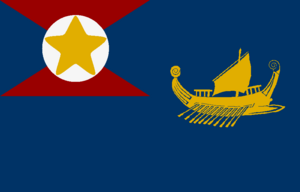 The Flag of the Kouralian Royal Navy | |
| Founded | 350 BCE |
| Current form | 2001 |
| Headquarters | Palæe Naughilus |
| Leadership | |
| Queen | Alyxandra Campbell |
| Legatine Justiciar | Tamæra Carfagna |
| Lord and Master of the Admiralty | Sir Alessya Cæryn |
| Personnel | |
| Military age | 18-63 |
| Conscription | Not in Effect |
| Active personnel | 2,500,000 |
| Reserve personnel | 300,000 |
The Kouralian Royal Navy is the marine warfighting service of the Kouralian Military and is a fully fledged Blue-Water Navy which operates throughout Mystria and beyond. While it is not the 'favoured child' of the three service branches, the Navy still operates a modern, disciplined, and well-equipped force.
It is responsible for crewing all ships, landing craft and patrol boats in the military - though there are some smallcraft operated by the Corps of Engineers of the Royal Army, or by the Air Force's Coastal Warfare Command. The Navy also has responsibility for all aircraft embarked on Naval ships and for the Fleet Fusilier Guard - a force of infantrymen who secure naval vessels and facilities, along with assisting army expeditionary troops in landings.
History

The Navy can trace its lineage back to the Læfaaſtyc Legionæ which were originally a part of the Crown Host - the professional predecessor to the Royal Kouralian Army. These were a blend of civilian mariners who ran the ships and oarsmen who were little more than uneducated labourers to propel them, and the trained soldiers and officers who did the fighting and commanded the ships. An average ship might have a Sailing Master who was a civilian ship's captain who was responsible for seamanship and for managing the sailors and oarsmen. It would also have a Centenær who, on land, would be in charge of roughly a hundred Legionaries, but at sea may be in charge of twenty to thirty soldiers on top of the sailing crew. This Centenær was responsible for directing the Sailing Master where to go, and when battle was joined he would take responsibility for overall command.
The professionalism of the Navy took a long time to catch up with the Army, and it wasn't until roughly the twelfth century that the modern 'Warfare' Trade began to take over responsibility for Seamanship, but still it took many more centuries before enlisted sailors became professionals rather than coerced labourers.
Doctrine
The Navy has always traditionally been defined by a subordinate role to the Army in its development and its employment. It joins the Air Force in operating dated war machines whose replacements lag behind the turnover of materiel by the Army, and while it rarely struggles to meet recruitment quotas it also joins the juniormost service in having to turn away a far smaller proportion of hopefuls. When it comes to warfighting the maritime sphere is rarely considered in isolation as a form of limited warfare - for example the establishment of a blockade or interdiction of shipping. This is because it is hard for the Kouralian to conceive a war that lacks any form of ground combat.
On a grand-strategic scale the Navy is seen either as the speedbump that screens out some of the chaff before the Army defends the homeland, or it is the cannon which launches the Army into combat against the opposing nation. This is much to the chagrin of the Office of the Admiralty and Marine Affairs, where senior naval officers often have to work far harder than Army or Air Force commanders to advance their service's policies or to advocate for their deployment.
Organisation
High Command
The Admiralty Board is the professional high command of the Navy. It is made up of the senior-most staff officers, and is regularly joined by senior elected and appointed civilians such as the Justiciar of State for War, or senior civil servants. The Chair of the Admiralty is assisted by the Principal Fleet Warrant Officer, who is the service's senior enlisted advisor. It is their responsibility to keep a link open between the high command and enlisted personnel.
- Lord and Master of the Admiralty - professional head of the Royal Navy.
- Vice-Master of the Admiralty, and Master of the Shore - Deputy to the Chair, and responsible for Fleet Reserves and Shore Establishments.
- Master of the Fleet - responsible for all operational management of vessels.
- Controller of the Fleet - responsible for technical support, outfitting, and procuring of vessels.
- Master of Fleet Supplies - responsible for supplying the navy, and his responsibilities included transport, victualling (supplying food), and medical services.
- Admiral-Adjutant - responsible for personnel development and support, and training.
The Admiralty Board does not exercise operational command of naval forces, as this is passed down via the Joint Service Commands. However, it is responsible for ensuring that sufficient vessels are allocated to each Joint Naval Command to meet its purpose, as well as ensuring they are sufficiently staffed and equipped.
Administrative Services
The Kouralian Navy is divided into multiple branches which are responsible for the administration of particular areas of responsibility. These are all overseen by the Office of the Admiralty and Marine Affairs, the sub-division of the civilian Justiciary of War that is responsible for overseeing the Navy. The Office is also manned by Staff officers from the Naval Staff.
- The Surface Fleet is responsible for management of all surface combat vessels such as Frigates, AIrcraft Carriers, and even smallcraft like Minehunters and Patrolboats.
- The Underfleet is responsible for management of all submarines.
- The Airfleet is responsible for management of all embarked aircraft - whether that be squadrons of strike bombers on a carrier or the single embarked helicopter on a corvette.
- The Expeditionary Fleet is responsible for management of all Amphibious Warfare ships, and also for the management of the Fleet Fusilier Guard. These are naval personnel who are primarily responsible for force protection and public facing duties, and limited infantry roles during expeditionary operations.
- The Auxiliary Fleet is responsible for management of all the Fleet Auxiliary vessels like replenishment oilers, hospital ships, and even mobile workshops capable of performing serious maintenance on ships overseas.
Personnel & Trade Branches
All personnel are divided into one of the nine Trade Branches, within which they will have a particular specialism that encompasses their day job. The Trade of an enlisted rate is denoted in by a Rate insignia on their right sleeve which complements their rank insignia on the left. Officers wear coloured distinction cloth between the rings on their sleeves, or the devices on their shoulder boards are backed with cloth of that colour.
- The Warfare Trade are responsible for the operation of most of the systems on any warship, with personnel divided up into the General Service, Airfleet, and Underfleet branches. Specialisms include Warfare Specialist, Hydrographic & Meteorological Specialist, Fleet Regulator, Naval Airman, and Communication Information Systems Specialist Submarine. Naval vessel commanders are drawn solely from this Trade. Officers of this trade technically wear dark blue distinction cloth, but practically speaking this is represented by having no distinction cloth. Uniquely, Regulating officers wear Regulation Blue distinction cloth.
- The Engineering Trade are responsible for maintaining and repairing physical equipment, and personnel are divided up into the Weapons, Marine, and Aviation Engineering branches. Specialisms include Technician, Artificer and Mechanic for each branch. Officers of this Trade wear orange distinction cloth.
- The Medical Trade are responsible for the provision of general and combat medical care to servicepersons - whether that be on a hospital ship, in a naval hospital, or in the clinic on a regular warship. Specialisms include nurses, medical technicians and medical assistants. Officers of this Trade wear red distinction cloth.
- The Logistics Trade are responsible for providing food, fuel, hospitality and general administration to the Fleet. Specialisms are Chef, Steward, Writer, and Supply Chain. Officers of this Trade wear pale blue distinction cloth.
- The Sacoracy Trade consists purely of Commissioned Ðyacoſæ and Enlisted Ðyacos' Assistants who are responsible for providing counselling, confidantes, and theological services to the fleet. Officers of this Trade wear white distinction cloth.
Operational Formations
The Naval Forces assigned to each Joint Service Command are usually made up of permanent formations into and out of which ships are assigned depending on personnel, maintenance, and supplying needs. These ships and smaller formations can be brought into and out of the responsibility of Joint Service Commands by the Admiralty Board, however the Admiralty Board is tasked with ensuring that all JSC Naval Headquarters are adequately staffed to accomplish any strategic aims they are assigned. For the Admiralty Board to remove forces from a JSC without consulting its commander would be an extreme act.
Formations of ships are generally described as follows:
- A Numbered Fleet is the term for a plurality of Fleets and attached Squadrons. This is usually a permanently established formation into and out of which lesser formations are brought as and when required and which is usually tied to a Joint Service Command. An example of this is the 1st, or Grand Fleet which is a part of Home Command.
- A Battlefleet is the term for the main component of a naval fighting force. That is a Carrier Battlesquadron, a Cruiser Battlesquadron, and two Escort Battlesquadrons.
- A Battlesquadron is the term for any grouping of vessels which is led by a Carrier or a larger class of Amphibious Warfare vessels.
- A Squadron is any grouping of vessels not led by one of the above types of vessels.
As an example, the 2nd, or Eastern Fleet is attached to Mystrian Naval Command. This is made up of a number of patrol, escort, and shore-based support squadrons along with both Battlefleet Alexander Kazansky and BattlefleetHelena Wells and an Expeditionary Battlesquadron. The Battlefleet Alexander Kazansky is based at JFB Progress Hill in the United Kingdom of Malgrave and is made up of the Carrier Battlesquadron Alexander Kazansky, a Cruiser Squadron and two Escort Squadrons. Meanwhile the Battlefleet Helena Wells is based in the Kouralian colony and is made up of the Carrier Battlesquaron Helena Wells, a Cruiser Squadron and two Escort Squadrons. Supporting this are Mine-Countermeasure Squadrons, independent Escort Squadrons of Corvettes, Frigates and Destroyers, Patrolboat Squadrons at each base, Shore-based Aviation Squadrons, and Auxiliary supply Squadrons.
Personnel
Uniforms
Like most Kouralian uniformed services, the Navy has specific 'Numbers' of Dress uniform which correspond to different levels of ceremony and formality. Traditionally each Number of Dress uniform is of a very similar style to the other service's uniforms of that Number. Within the service, the uniform varies slightly depending on the rank or role of the wearer.
- Full Dress or the Steel-dress consists of an embroidered navy blue undertunic worn with an enamelled muscle-breastplate with enamelled pteruges embossed with maritime imagery. This uniform is usually worn with a plumed helmet, and a sword cross-belt that is cinched to the waist by a waist sash of navy blue. This uniform is usually worn either with calf-high sandals that act as a scabbard for the traditional Kouralian knife, or it is worn with boots and calf-high socks with a scabbard for the traditional Kouralian knife. This uniform is usually only worn by the sovereign or a contingent commander at a triumph, or when mounting the Coronial Life Guard.
- No.1 Dress or Closed-Collar dress consists of navy blue double-breasted tailcoat with eight gold buttons worn in two rows, standing collar faced white with gold edging, gold epaulettes and gold laced blue trousers. It is worn with a peaked cap or, if by an officer of Flag rank then they can wear it with a cocked hat. As footwear this is worn with calf-boots, while this uniform is almost always worn with a full dress sword belt embroidered with oak leaves or a full dress sword belt with three stripes. This uniform may only be worn by commissioned officers of a legatine rank in the most formal of situations - for example more junior legates at a Triumph, or during their dubbing ceremony.
- No.2 Dress or Open-Collar dress for officers consists of a double-breasted, navy blue jacket with two rows of four gold buttons; matching trousers; white shirt and navy blue tie; peaked cap; and black leather shoes. Enlisted personnel wear a navy blue sailor suit with a blue home service helmet. Different versions of this uniform come with arms - whether sword or rifle and/or medals.
- No.3 Dress or Barracks Dress consists of navy blue trousers and a white or blue shirt depending on the rank of the wearer with rank insignia on the shoulders, and a peaked cap or beret depending on the rank of the wearer. This can be worn with long sleeves and a navy blue tie, short sleeves and no tie, or with a blue jumper. This is identical for officers and enlisted personnel bar the headdress.
- No.4 Dress or Sea Dress of a navy blue fire-retardant jacket (worn tucked in and with the sleeves rolled up), navy blue beret, navy blue stable belt, navy-blue fire-retardant trousers, steaming boots, navy-blue T-shirt and an optional navy-blue microfleece. Bar rank insignia, this is universal for all personnel.
- No.5 Dress or Duty dress is whatever specialist uniform is required when on duty, whether that be flight suit or wetsuit.
- Dress Whites are worn in tropical circumstances rather than No.2 Dress. Officers wear a short sleeved white bush jacket with an open collar; matching trousers; peaked cap; and white leather shoes. Senior officers may optionally wear instead a long-sleeved, high-necked white tunic, with five buttons down the front, worn with white trousers and white shoes. Rank on both is indicated on the shoulder. Enlisted personnel wear white shirts with white shorts and boat shoes and a white coated Home Service Helmet.
Ranks
The Officers of the Kouralian Navy hold leadership and management roles, though are rarely trained with in-depth technical knowledge about the systems they are responsible for. They usually do not directly operate warfare, engineering, communication, or other technical equipment. Principal exceptions to this are Hydrographical and Meteorological Officers whose expertise and education is traditionally commensurate with the authority and remuneration that a commission entails, Pilots, and Nuclear Reactor Supervision Officers.
The commissioned officers' rank insignia of the Kouralian Navy is generally represented by golden rings which are worn on the sleeve or on shoulder boards. The number of rings goes up sequentially with ranks, with the uppermost level being two rings intertwined that act in place of an executive curl. Alternative shoulder board rank insignia exist for senior officers' uniforms, while junior officers wear exact replicas of their rank rings on shoulder boards.
| OF10 | OF9 | OF8 | OF7 | OF6 | |
|---|---|---|---|---|---|
| Naval Legatine-Grade Ranks | |||||
Rank Title
|
Grand Admiral
|
Master Admiral
|
Admiral
|
Vice-Admiral
|
Legate-At-Sea
|
Kouralian
Title |
Legatus-Naughilus
Magnamyræl |
Legatus-Naughilus
Mæyst'Amyræl |
Legatus-Naughilus
Amyræl |
Legatus-Naughilus
Vys-Amyræl |
Legatus-Naughilus
|
Abbreviation
|
LGrAdm.
|
MAdm.
|
Adm.
|
VAdm.
|
Leg.C
|
Insignia
|
|||||
Typical
Command/ Appointment |
Chief of Naval/Defence Staff
|
Joint Forces Command
|
Numbered Fleet
|
Battlefleets
|
Battlesquadrons
|
| OF5 | OF4 | OF3 | OF2 | OF1 | |
|---|---|---|---|---|---|
| Naval Fleet-Grade Ranks | |||||
Rank Title
|
Captain-At-Sea
|
Centenar-At-Sea
|
Vice-Centenar-At-Sea
|
Master-Vintenar
|
Vintenar - Ensign
|
Kouralian
Title |
Capitæyn-Naughilus
|
Centenær-Naughilus
|
Vys-Centenær-Naughilus
|
Mæyster Vyntenær
|
Vyntenær - Veſſilian
|
Abbreviation
|
Capt.
|
Ctr.
|
VCtr.
|
MVtr.
|
Vtr. - En.
|
Insignia
|
|||||
Typical
Command/ Appointment |
Capital ships and
Escort squadrons |
Escort vessels
|
Minehunters and Patrolcraft
|
Held after 3 years
|
Held respectively for first year
and then for three years after |
The enlisted, or Other Ranks' insignia of rank is worn on the left sleeve of formal uniforms to complement the Rate Insignia on the right sleeve. On less formal uniforms it is worn on a slider on the shoulder, like that of commissioned officers. It is traditionally gold in colour to stand out against the backing, or blue when worn on Dress Whites. Warrant Officers - the uppermost grade of enlisted personnel who act as technical experts or as senior enlisted advisors to commanders, wear rank insignia on their shoulders on formal dress uniforms.
| OR 10 | OR 9 | OR 8 | OR 7 | |
|---|---|---|---|---|
| Naval Warrant Officers | ||||
Rank Title
|
Master Warrant Officer
|
Leading Warrant Officer
|
Warrant Officer Class I
|
Warrant Officer Class II
|
Kouralian
Title |
Mæyst'Æiutante
|
Æiutante Sceltiæ
|
Æiutante Primo
|
Æiutante
|
Abbreviation
|
MWO
|
PWO
|
WO1
|
WO2
|
Insignia
|
||||
Typical
Command/ Appointment |
Command SEA
|
Legatine SEA
|
Executive Warrant Officer
|
Departmental Snr. Rating
|
| OR6 | OR5 | OR4 | OR3 | OR2 | OR1 | |||
|---|---|---|---|---|---|---|---|---|
| Naval Other Ranks | ||||||||
Rank Title
|
Master Petty Officer
|
Petty Officer
|
Leading Rate
|
Able Seaman
|
Seaman Ordinary
| |||
Kouralian
Title |
Mæyster Sottuffigiær
|
Sottuffigiær
|
Marinus Sceltiæ
|
Marinus Abiliæ
|
Marinus Ordinariæ
| |||
Abbreviation
|
MPO
|
PO
|
LR
|
AB
|
OD
| |||
Insignia
|
||||||||
Typical
Command/ Appointment |
Senior Rating
|
Senior Rating
|
Specialism/Seniority Grade
|
Basic Grade
|
Held for 2 years
| |||
Equipment
The Kouralian Fleet uses a wide range of equipment - the widest of any of the three military services. It not only makes use of land vehicles such as cars and lorries to patrol its facilities and transport supplies and men, but also makes use of fixed and rotary wing aircraft launched from naval vessels: and this is before considering the naval vessels themselves. A Colonel acting as the Commanding Officer of an Armoured Cohort oversees 600 men who employ in the realm of 50 main battle tanks - each operated individually by a crew of four that is overseen by a junior non-commissioned officer. On the other hand, a Centenar-At-Sea will oversee a single billion dollar ship and a crew of roughly two hundred: his personnel are all working towards the continuing combat effectiveness of that solitary fighting vessel.
Aircraft Carriers
| Class | Origin | Image | Stats | Details |
|---|---|---|---|---|
Fleet Supercarrier 30 Hulls |
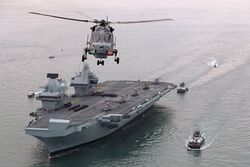 RKNV Queen Alyx-En-Fidelis |
Displacement: 172,305 tons Length Overall: 424.2m Beam: 80.1m Depth: 12.5m Complement: 1,550 Air Crew: 3,000 Speed: 35kts Sustainable Range: Unlimited |
The Hero-Class of Fleet Supercarriers make up the main offensive power of Kouralian fleets at sea, with delivery from the Freestian FDI Group beginning in 2015 and ending in 2018. They are highly modernised twin-island carriers designed to operate STOVL fixed-wing aircraft at a high operational tempo, with a huge Embarked Aviation Group of 130 airframes to support this. Commanded by Captains, they are the flagships of their Battlesquadrons, though are usually not the Battlefleet's Flagship due to their priority as a target. | |
Light Carrier 30 Hulls |
 RKNV Father-Of-The-House |
Displacement: 22,000 tons Length Overall: 209m Beam: 36m Depth: 8m Complement:650 Air Crew: 350 Speed: 18kts Sustainable Range: 8,100 Miles |
The Senator-Class were originally the only serious aviation assets for the Kouralian Navy until the Fleet Carrier Project bore the fruits of the Hero-Class. They are significantly smaller and older than the Hero-Class - carrying only 21 Airframes, but can still undertake fully independent defensive and offensive ASaC, ASW and ASuW aviation operations.
These Ships are commanded by Captains. | |
Aviation Cruiser 69 Hulls |
 RKNV Fireball |
Displacement: 14,150 tons Length Overall: 180.2m Beam: 33.4m Depth: 8.2m Complement: 550 Air Crew: 180 Speed: 30kts Sustainable Range: 8,100 miles |
Significantly smaller and with significantly less capability, the Magic-Class of Flight-Deck Cruisers are intended to act as screening escorts and redundancy hulls for the aviation assets of any Kouralian battlefleet. They can operate STOVL craft, but are usually restricted to rotary-wing air operations, being able to operate limited ASW, ASuW and ASaC capabilities with their complement of 18 Airframes.
These ships are commanded by Captains. A number of these ships operate independently as the lead ships of the Kouralian Navy's Coastal Command's Extended-Range Interdiction Areas. |
Amphibious Warfare Ships
| Class | Origin | Image | Stats | Details |
|---|---|---|---|---|
Landing Platform Helicopter 30 Hulls |
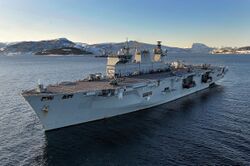 KCS Leopard in on exercise in Malgrave |
Displacement: 21,500 tons Length Overall: 203.4m Beam: 35m Depth: 6.5m Complement: 460+830 Speed: 18kts Sustainable Range: 8,000 miles |
The Lord-Class | |
Landing Platform/Dock 30 Hulls |
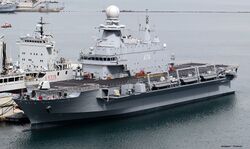 KCS Fauchard in port |
Displacement: 8,800 tons Length Overall: 142.9m Beam: 21.5m Depth: 5.3m Complement: 152+430 Speed: 20kts Sustainable Range: 7,000 miles |
The Sword-Class | |
Landing Platform/Dock 30 Hulls |
 KCS Tower at sea |
Displacement: 19,560 tons Length Overall: 176m Beam: 28.9m Depth: 7.1 Complement: 325+405 Speed: 18kts Sustainable Range: 8,000 miles |
The Castle-Class | |
Dock Landing Ship 30 Hulls |
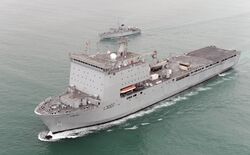 KCS Færyello at sea |
Displacement: 16,160 tons Length Overall: 176.6m Beam: 26.4m Depth: 5.8m Complement: 150+500 Speed: 18kts Sustainable Range: 8,000 miles |
The Mountain-Class |
Guided Missile Cruisers
| Class | Origin | Image | Stats | Details |
|---|---|---|---|---|
Guided Missile Cruiser 30 Hulls |
 Diagramatic View of RKNV Temeraire |
Displacement: 23,405 tons Length Overall: 224.2m Beam: 60.1m Depth: 12.5m Complement: 230 Speed: 39kts Sustainable Range: Unlimited |
The Temeraire-Class of Guided Missile Cruisers from the Freestian FDI Group were supplied in conjunction with the Hero-Class's deal. They act as missile-carrying support ships which can tackle targets at sea, on land and in the air. They are commanded by Captains and are usually Battlefleet Flagships. |
Escorts
| Class | Origin | Image | Stats | Details |
|---|---|---|---|---|
| Air Defence | ||||
Guided Missile Destroyer ?? Hulls |
 RKNV Vygean manoeuvring at sea. |
Displacement: 7,050 t Length Overall: 152.87 m Beam: 20.3m Depth: 5.4m Complement: 236 Speed: 29kts Sustainable Range: 6,100 Miles |
The Prefect Class was intended as the replacement for the Prince-Class and is significantly higher tech, with far more powerful sensors and much greater automisation. The ship has 8 Anti-Surface Missiles, a 48-cell Anti-Air VLS System, 3 76mm guns, 2 single-tubes for torpedoes with 24 carried, and 2 25mm automatic cannons. The vessel features no CIWS, though the 76mm guns can fulfil that role. The vessel can carry one medium-sized helicopter. | |
Guided Missile Destroyer ?? Hulls |
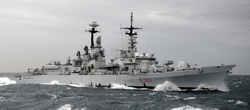 RKNV Palatine |
Displacement: 4,500 t Length Overall: 147m Beam: 16.1m Depth: 5m Complement: 380 Speed: 32kts Sustainable Range: 7,000 Miles |
The Prince-Class of Anti-Air Escorts are currently legacy vessels, which only avoided complete phasing out due to the expense of the Prefect-Vessel Programme. They are heavily armed vessels, with one main 155mm gun and three 76mm guns, 4 Surface-to-Surface missiles, a number of SAM missile Launchers, and two triple torpedo launchers. The vessel features no CIWS, though the 76mm guns can fulfil that role. The high concentration of armaments on a small hull necessitates the high crew count compared to other ships. The vessel can carry two small helicopters. | |
| Anti-Submarine Warfare | ||||
ASW Frigate ?? Hulls |
 RKNV Prosecutor firing main gun |
Displacement: 4,900 t Length Overall: 133m Beam: 16.1m Depth: 7.3m Complement: 185 Speed: 28kts Sustainable Range: 7,500 Miles |
||
| General Purpose | ||||
Frigate ?? Hulls |
 Diagramatic View of RKNV Emancipare |
Displacement: 3,400 t Length Overall: 120.2m Beam: 15.2m Depth: 5.2m Complement: 85 Speed: 25kts Sustainable Range: 7,400 Miles |
Like other Freethinker vessels in service with the Kouralian Navy, the Freedom-Class are the most modern vessels in service, and make great use of automation and digital design to decrease the crew requirements. The vessels are smaller and less capable than designated AA and ASW escorts, however the modernisation helps them bridge the gap and provide economical general purpose support to the fleet. Each vessel has a 155mm gun in the bow for shore gunnery, and two quad launchers for the standard anti-surface missile. A 16-cell OceanCeptor VLS is installed behind the gun, as is a Rolling AIrframe Missile CIWS above the hangar. Also installed are torpedo catapults and manual guns for countering smallcraft and port-defence. | |
Corvettes and Patrol-craft
| Class | Origin | Image | Stats | Details |
|---|---|---|---|---|
| Corvettes | ||||
Corvette |
 |
Displacement: 1,840 t Length Overall: 89.12 m Beam: 13.28 m Depth: 3.4 m Complement: 65 Speed: 26kts Range: 7,400 km |
The Admiral-Class of corvettes are not typically used as escorts, however they are the smallest full-spectrum warships in the fleet. They feature 4 anti-ship missiles mounted amidships and two RAM missile CIWS launchers, along with a 76mm autocannon, two 25mm autocannons, and racks for minelaying. The vessel can also carry a small helicopter and a pair of UAVs in its hangar. | |
| Patrol craft | ||||
Offshore Patrol Vessel |
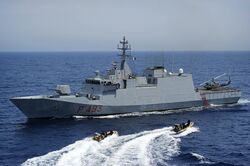 |
Displacement: 1,520 t Length Overall: 88.6 m Beam: 12.2 m Depth: 3.37 m Complement: 70 Speed: 25kts Range: 6,500 km |
The Captain-Class of offshore patrol craft provide the majority of the security for Kouralian territorial waters along side vessels of the Crown Waterguard. They do not have missile armament, but do have a 76mm cannon and a pair of 25mm autocannons, and have a hangar for an embarked helicopter and two embarked offshore raiding craft. | |
Offshore Patrol Vessel |
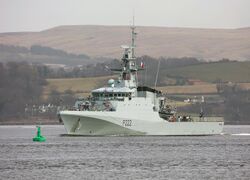 |
Displacement: 2,000 t Length Overall: 90.5 m Beam: 13.5 m Depth: 3.8 m Complement: 58+50 Speed: 25kts Range: 10,200 km |
Centenær-Class vessels provide long-range shipping patrols across between West and East Mystria due to their extreme endurance, along with assisting in patrolling the Forynthry Naval Exclusion zone. They feature a 25mm cannon on the forward deck, two rotary-barrelled permanent machinegun mounts, and two further mounts for machine guns. They also feature a flight deck which can land a medium-sized helicopter, though have no hangar for continuous air operations. | |
Patrol Boat |
 |
Displacement: 54 t Length Overall: 20.8 m Beam: 5.8 m Depth: 1.8 m Complement: 12 Speed: 25kts (Standard) 45kts (Sprint) Range: 1,020 |
The Vyntenaer-Class of Riverine and Harbour patrol boats are mainly used for security patrols at major Naval facilities, escorting vessels in littoral waters, and providing security at other sensitive sites such as research facilities and royal palaces. They are armed with two mounts for machine guns, and can feature a 25mm automatic cannon on the forward deck. | |
Logistical Support Craft
Smallcraft
| Class | Origin | Image | Stats | Details |
|---|---|---|---|---|
| Landing Craft | ||||
Landing Craft Vehicle Personnel |
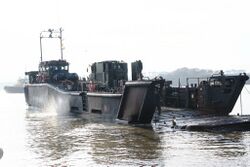 LCU landing vehicles |
Displacement: 240 t Length Overall: 29.82 m Beam: 7.70m Depth: 7.70m Complement: 7+120 Speed: 19kts (Full) 40kts (Empty) Range: 600 Miles |
The Kouralian LCU No.7 is a 'Partial Air Cushion Supported CATamaran' fast landing craft capable of carrying a full MBT to shore rapidly. Alternatively it can carry as many as four APCs, or a company of marines to shore | |
Landing Craft Vehicle Personnel |
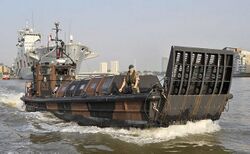 LCVP transiting Kurton |
Displacement: 24 t Length Overall: 15.7 m Beam: 4.3m Complement: 3+35 Speed: 25kts (Full) Range: 240 Miles |
The LCVP is a smaller landing craft intended for carrying a platoon of marines or a small vehicle to shore. Four of them can carry a full company of marines to shore. It can be equipped with a pair of GPMGs mounted at the front to provide suppressing fire as it lands people. | |
| Special Warfare Craft | ||||
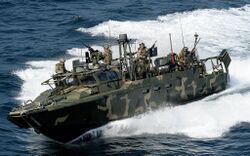 FAC at Sea |
Displacement: 15.3 t Length Overall: 15.9 m Beam: 3.8m Depth: 0.8m Complement: 3+18 Speed: 40kts (Full) Range: 270 Miles |
The F/LAC is a smaller, faster, and more heavily armed boat which is able to carry roughly half a platoon of men to shore. It can be equipped with up to four side-facing pintle mounts for weapons, and a central heavier weapon system such as an auto-cannon RCWS or a GMG mount. It can also deploy two jet skis, 4 sea mines, or six depth charges from rear racks. | ||
 ORC Landing troops on exercise in Malgrave |
Displacement: 4.7t(full) Length Overall: 9.1m Beam: 2,9m Depth: 0.69m Complement: 3+12 Speed: 32kts (Full) Range: 230 miles |
The Offshore Raiding Craft is a small boat used for patrol and troop insertion - traditionally for strategic reconnaissance such as landing beach assessment parties. It can be equipped with armouring panels and had three pintle mounts for machine guns. | ||
 RRC transiting Kurton |
Displacement: 2.5t(full) Length Overall: 6.5m Beam: 1.9m Complement: 11 Speed: 33kts (Full) Range: 100 miles |
The Rigid Raiding Craft is a small boat used to carry men around rivers, between ships and shore, and to patrol shore establishments. | ||
Inflatable boat |
 IRC Transiting jungle river |
Displacement: 1.25t(full) Length Overall: 5m Beam: 1.9m Complement: 6 Speed: 20kts (Full) Range: 2 hours |
The Inflatable Raiding Craft is a small boat used to carry men around rivers, between ships and shore, and to patrol shore establishments. | |
Other Craft
Submarines
| Class | Origin | Image | Stats | Details |
|---|---|---|---|---|
| Missile Submarine | ||||
Missile Submarine ?? Hulls |
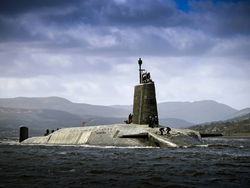 RKNV Culverin coming into Port |
Displacement: 15,900 t (submerged) Length Overall: 149.9m Beam: 12.8m Draught: 12m Complement: 135 Speed: 25kts submerged Range: Unlimited |
The Cannon-Class of ballistic missile submarines provide a continuous at sea nuclear deterrent for the Kouralian Navy. They have sixteen ballistic missile tubes, each of which can hold a missile with up to 8 warheads, and 4 torpedo tubes. | |
| Fleet Submarine | ||||
Fleet Attack Submarine ?? Hulls |
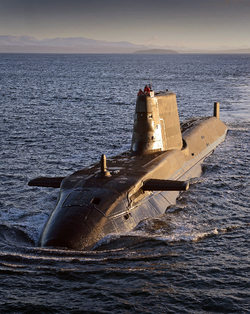 RKNV Warmaster at Sea |
Displacement: 7,600 t (submerged) Length Overall: 97m Beam: 11.3m Draught: 10m Complement: 98 Speed: 30kts submerged Range: Unlimited |
The Warmaster-Class of Fleet Attack Submarines bring a more covert anti-ship capability to Kouralian Fleets operating at a distance from shore facilities and refuelling facilities. They are faster than diesel vessels, and being significantly larger enables them to carry 38 torpedoes or land attack missiles for launch from 4 tubes. They can also carry Frogman-delivery facilities. | |
| Littoral Submarine | ||||
Littoral Attack Submarine ?? Hulls |
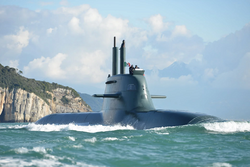 RKNV Hammerhead at Sea |
Displacement: 1,830 t (submerged) Length Overall: 57.2m Beam: 6.8m Draught: 6.4m Complement: 27 Speed: 12kts surface, 20kts submerged Range: 9,200 Miles |
The Shark-Class is a diesel and air-independent propulsion submarine class designed to operate very close to shore in highly stealthy conditions, for example to harass amphibious shipping, lay mines, or ensure delivery of naval frogmen ashore. It can operate in as little as 17m of water, and can remain submerged for as long as 18 days. The Submarine has 6 torpedo tubes, and can carry 13 torpedoes or 4-pack AA missiles capable of being launched while submerged. It can also carry up to 24 sea-mines externally. The mast contains a single recoil-less 25mm cannon which can be deployed while the vessel is submerged, and up to three short-range UAVs. | |
